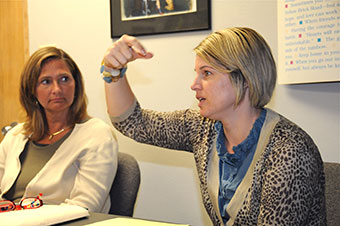Gibsonburg Exempted Village School District
Other Improvement Efforts
Changing Structures and Culture to Facilitate Improvement
During the 2014-15 school year, Gibsonburg’s recently hired high-school principal moved into the superintendent role. He then put together a team of strong new administrators that included his replacement as high school principal, other building principals, and the special education director. Together they helped foster a more open and productive culture. Teachers credit the administrative team with nurturing a climate of positivity, improving morale, stimulating collaboration, and opening up communication in the district.
The year before the current superintendent was employed, the ODE mandated that Gibsonburg begin the OIP process. The work was undertaken in the spirit of compliance. A year later, the new administrative team reanimated the process, not as an exercise in compliance, but as a collaborative venture to bring about instructional improvement. Frequent communication with other schools to learn about improvement practices in their districts, and consultations with the SST representative, proved helpful to Gibsonburg’s improvement process.

The district’s new leaders focused on the OIP teams as they strove to reshape cultural norms. The administrators modified team processes and structures to maximize educators’ participation and engagement. They initiated the use of different team groupings—sometimes grade-level and sometimes multi-grade—which brought a diversity of voices and ideas to team discussions and promoted vertical alignment across the schools. OIP leadership teams worked to identify effective instructional practices, and the teachers employed these practices. Conversations about data shifted from a summative mode (accountability test scores) to a formative mode that supports instructional improvement and enables teachers to align instructional strategies with student needs. Dedicated use of the five-step process reoriented communication in the district from a top-down direction to an upward flow of information.
The administration’s increased transparency contributed to improved communication at every level in the district, and helped unify the efforts of teachers, administrators, board members, and parents. Gibsonburg’s OIP teams have given teachers a voice in district decision-making. Recently, TBT teams helped the district select a new reading/language arts curriculum and plan professional development. Cross-team collaboration has enabled teams to address district-wide issues such as behavior management. Empowering OIP leadership teams to play a more active role in shaping district decisions is especially beneficial in small districts like Gibsonburg that employ few administrators.
Working on Direction, Alignment, and Commitment
When the new superintendent came on board, the Gibsonburg School District was suffering an “identity crisis.” Years of budget difficulties, leadership and staffing changes, and declining accountability test scores had eroded morale, focus, and motivation. District improvement efforts lagged.
The superintendent recognized the need to articulate a coherent set of goals and strategies, build a climate of trust and open communication, and renew enthusiasm and commitment to the improvement process. He formed a study group to discuss the book Direction, Alignment, Commitment: Achieving Better Results through Leadership by McCauley and Fick-Cooper. The superintendent and his team of new building administrators implemented the guidance and structures needed to reinvigorate the OIP teams and addressed school issues such as discipline and meeting high expectations. Gibsonburg’s leaders encouraged teachers to draw on the district’s past successes and strengths to build enthusiasm and confidence for new initiatives.
District teachers, many of whom have had a long history with the district, were quick to “buy in” to the district’s new initiatives and expectations. The strengthened OIP teams increased communication and collaboration, which in turn built enthusiasm for the improvement initiatives. The superintendent believes that direction and commitment in the district are well established, but alignment is still a work in progress. He hopes to establish greater coherence; however, the tactics for doing so remain unspecified.